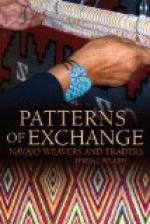[Illustration: FIG. 49.—Navajo blanket of the finest quality.]
The accompanying pictures of blankets represent some in my private collection. Fig. 49 depicts a blanket measuring 6 feet 9 inches by 5 feet 6 inches, and weighing nearly 6 pounds. It is made entirely of Germantown yarn in seven strongly contrasting colors, and is the work of a man who is generally conceded to be the best weaver in the tribe. A month was spent in its manufacture. Its figures are mostly in serrated stripes, which are the most difficult to execute with regularity. I have heard that the man who wove this often draws his designs on sand before he begins to work them on the loom. Fig. 50 a shows a blanket of more antique design and material. It is 6 feet 6 inches by 5 feet 3 inches, and is made of native yarn and bayeta. Its colors are black, white, dark-blue, red (bayeta) and—in a portion of the stair-like figures—a pale blue. Fig. 50 b depicts a tufted blanket or rug, of a kind not common, having much the appearance of an Oriental rug; it is made of shredded red flannel, with a few simple figures in yellow, dark blue, and green. Fig. 51 represents a gaudy blanket of smaller size (5 feet 4 inches by 3 feet 7 inches) worn by a woman. Its colors are yellow, green, dark blue, gray, and red, all but the latter color being in native yarn. Figs. 52 and 53 illustrate small or half-size blankets made for children’s wear. Such articles are often used for saddle blankets (although the saddle-cloth is usually of coarser material) and are in great demand among the Americans for rugs. Fig. 53 has a regular border of uniform device all the way around—a very rare thing in Navajo blankets. Figs. 54 and 55 show portions of coarse blankets made more for use use than ornament. Fig. 55 is made of loosely-twilled yarn, and is very warm but not water-proof. Such blankets make excellent bedding for troops in the field. Fig. 54 is a water-proof serape of well-twilled native wool.
[Illustration: FIG. 50.—Navajo blankets.]
[Illustration: FIG. 51.—Navajo blanket.]
[Illustration: FIG. 52.—Navajo blanket.]
[Illustration: FIG. 53.—Navajo blanket.]
[Illustration: FIG. 54.—Part of Navajo blanket.]
[Illustration: FIG. 55.—Part of Navajo blanket.]
The aboriginal woman’s dress is made of two small blankets, equal in size and similar in design, sewed together at the sides, with apertures left for the arms and no sleeves. It is invariably woven in black or dark-blue native wool with a broad variegated stripe in red imported yarn or red bayeta at each end, the designs being of countless variety. Plates XXXIV and XXXV represent women wearing such dresses.
[Illustration: FIG. 56.—Diagram showing formation of warp of sash.]
[Illustration: PL. XXXVII.—ZUNI WOMAN WEAVING A BELT.]




